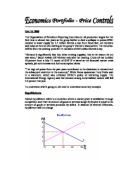-There is a freedom of exit or entry into the competition.
Short run:
-there is the possibility of making abnormally high profits the short run period, or abnormally low profits. If the profits are low, firms often leave during the short run period.
Long run:
-If firms make abnormally high profits during the short run, other firms will join the industry since there is free entry or exit to the market. This will result in higher competition and already existing firms losing their customers.
-If firms make losses in the short run period, they will often leave the industry.
This is why often many firms that manufacture and sell the same goods/services accumulate in the same area (e.g: silicon Valley U.S.A). That is why firms that accumulate in one area often try to distinguish themselves from one another through different offers, such as “open 24/7”
All firms, no matter what the result of the short run period was, will end up in the position of normal profits in the long run period. This means that each firm is covering exactly it’s costs. (see figure 10.4). This is another point where a monopolistic competition differs from a perfect competition.
Price Discrimination
-
It is a pricing policy that firms adopt to further increase then profits
-
It exists when a firm sells the same product at two or more different prices in two or more markets provided that price difference DO NOT reflects products or provision costs differences
Type of price discrimination
-
First degree price discrimination (perfect price discrimination → HIGHLY THEORITICAL)
-
Second degree price discrimination ( block price discrimination) – whole sale- “promotion”
-
Third degree price discrimination (most common)
Can all firms price discriminate?
No.
3 conditions to behind for price discrimination to be feasible:
- Firm must enjoy same free of monopoly
-
No resale of the good and the two markets must be separable
-
Price elasticity of demand between markets must differ
( Can consumers benefit from price discrimination? )
Market Failures and success
- When a market is in equilibrium with no external influence and no external effects, it is said to be in a state of PARETO optimality
-
PARETO optimality exists when it is impossible to make someone better off without making another one worse off. It does not, however mean that everyone is equal
-
If a market is at PARETO optimality, it is said to be socially efficient. Social efficiency exists when community surplus in maximized.
- Market Failure occurs when community surplus is not maximized
- When markets fail, governments are often expected to intervene in order to eliminate market failure and move towards the optimal allocation of resources
Types of Market Failure:
- Imperfect Competition
- Monopoly
- Monopolistic Competition
- Oligopoly
- Lack of public goods (parks, lightening...)
- Undersupply of merit goods (education, health services…)
- Oversupply of demerit goods (“sin” product: drugs, cigarettes…)
- Existence of externalities externality (pollution)
+: of production
Of consummation
-: of production (pollution)
Of consummation (smoking cigarette)
- Immobility of factors of production
- Problems of information
- Creation of inequality
- Short-termism







